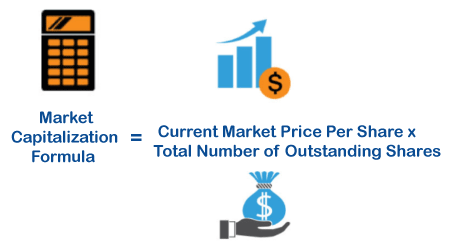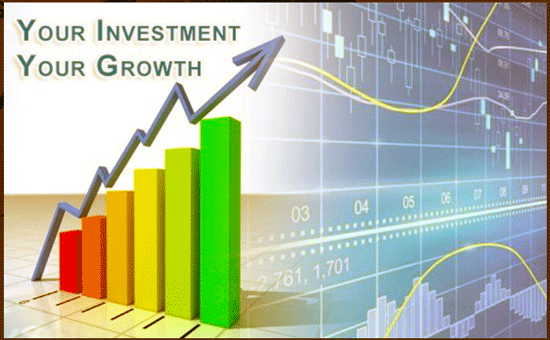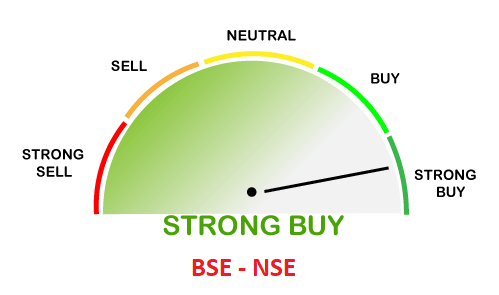BSE
BSE, or Bombay Stock Exchange, is the Indian stock exchange established on 9 July 1875. It is situated at Dalal Street, Mumbai. Dalal Street is the address of financial firms, BSE, and institutes in Mumbai. The stock market index of BSE consists of the list of 30 well-renowned and financial companies. Some of the traded stocks of these 30 companies are the largest and active stocks.
Market Capitalization
BSE Market Capitalization represents the market value of the company's shares. The actual market capitalization of the Bombay Stock Exchange was $2.2 trillion as of the year 2018. In 2018, BSE was the 10th largest stock exchange across the world. Bombay Stock Exchange is considered as the oldest stock exchange in Asia.
Sethurathnam Ravi is the chairman of the Bombay Stock Exchange since 2017.
The formula to calculate the market capitalization is shown below:

Important Terms
Let's discuss some terms that are essential to understand the concept of stock market exchange.
Points
The points in the stock market defined the dollars, where one point is equal to one dollar. So, if we lose 10 points, it means that we have lost 10 dollars. The points are generally used to describe gains, declines, result for the week, and other short term results.
Stock Market
The stock represents the collection of sellers and buyers of the stocks. The investments in stock are carried out via two platforms called electronic trading and stock brokerages. The electronic trading platform is defined as the online platform, which is generally used to place orders for the software's financial products. The stock brokerages are the investment broker or a trading representative.
Shares
A company can issue the shares to provide a hike to their investments for future projects. Investors can purchase these companies' stocks if they believe that they can retrieve these companies' future profits.
Investment
It is defined as the task for funding or investing the money for profit. It is also defined as the process of spending money to receive extra money in the future. The money is invested in various types of cycles.
SSE
SSE or Sustainable Stock Exchange is the initiative by the United Nations. It is a platform to inspect how exchanges work with companies, regulators, and investors to promote investment.
Bombay Stock Exchange was a part of the Sustainable Stock Exchange. It was considered as the first stock exchange from Asia to join the SSE.
BSE Companies
The 30 companies listed on the Bombay Stock Exchange are given below:
- HDFC Bank
- ICICI Bank
- SBI (State Bank of India)
- Axis Bank
- Kotak Mahindra Bank
- Induslnd Bank
- Asian Paints
- Mahindra & Mahindra
- HUL (Hindustan Unilever Limited)
- HDFC - Finance (Housing)
- ITC Limited
- Larsen & Toubro
- Maruti Suzuki
- Nestle India
- NTPC (National Thermal Power Corporation)
- TCS (Tata Consultancy Services)
- Tata Steel
- Titan
- Tech Mahindra
- UltraTech Cement
- Bajaj Finance
- Bharti Airtel
- Bajaj Fiserv
- Bajaj Auto
- HCL Technologies
- Infosys
- Reliance Industries Limited
- Power Grid Corporation of India
- Oil and Natural Gas Corporation
- Sun Pharma
History of BSE
The following are some historical points about the BSE:
- In the 1850s, five stockbrokers gathered for a meeting under the Horniman Circle (formerly known as Banyan Tree) situated in the Mumbai Town Hall.
- They further moved to the Mahatma Gandhi Road (formerly known as Esplanade Road).
- The brokers' population kept on increasing, due to which these five brokers have to shift again and again.
- In 1874, they founded a permanent location called Dalal Street.
- In 1875, the organization became official and named 'The Native Share & Stock Broker Organization.'
- The Bank of India started clearing the house on 2 February 1921.
- Bombay Stock Exchange got the permanent acknowledgment under the SCRA (Securities Contract Regulation Act) on 31 August 1957.
- India's first S & P BSE SENSEX equity index was launched on 2 January 1986.
- BSE introduced Online trading on 14 March 1995. It means that the Bombay Stock Exchange switched to an electronic-based system in 1995.
- In 1997, the BSE trading system was expanded nation-wide.
- BSE was incorporated as Bombay Stock Exchange Limited on 8 August,2005.
- BSE was recognized as the corporate entity on 19 August 2005.
- The Hindi and Gujarati website of BSE was launched in 2006.
- Singapore Exchange Limited specified an agreement to take a 5% stake in BSE on 7 March 2007.
- The mutual funds trading program was launched on 4 December 2009.
- BSE was the first to introduce mobile trading on 21 September 2010.
- Bombay Stock Exchange exceeded the market capitalization of USD 1 billion on 4 April 2014.
- The Market Cap of the companies listed in BSE SME () crossed the landmark of 10,000 crores on 12 December 2014.
- BSE becomes the fastest exchange on 13 October 2015 across the globe. The median response speed at that time was 6 microseconds.
- The BSE Star Mutual Fund processed the record of 81,000 orders of worth 270 crores.
- It becomes the first listed stock exchange of India on 3 February 2017.
- The commodity derivative segment from the list of segments of BSE becomes the first Universal Exchange of India on 1 October 2018.
BSE Sensex
Sensex is also known as the sensitivity Index. It represents the stock market index of the financial and established companies. S&P BSE SENSEX is considered as the main power of the domestic stock markets in India. BSE also launched the dollar-linked version on 25 July 2001. The full market capitalization of SENSEX on 28 February 2020 was about ₹152,112.3149 billion (US$2 trillion). The free-float market capitalization of BSE was ₹43,272.7852 billion (US$607 billion).

Stock Market Crashes
BSE has seen several crashes and booms in its journey. Let's discuss some of the significant crashes suffered by the Bombay Stock Exchange of India.
- 1992 Crash
BSE suffered from a fall of 12.77% on 28 April 1992. Harshad Mehta was responsible for this scam.
- Crash due to Sonia Gandhi Election is 2004
BSE suffered from a fall of 15.52% on 17 May 2004. The reason was the elections, which were won by Sonia Gandhi.
- 2006 Crash
BSE Sensex experienced a fall of 826 points to 11,391.
- 2008 Crash
BSE experienced a fall of 1408 points to 17,605 on 21 January 2008. The trading on BSE was closed for one hour after the fall on the benchmark Sensex fall.
Bombay Stock Exchange also suffered from 1070 points to 8701 in a single day on 24 October 2008.
- 2015 Crash
BSE Sensex experienced a crash by 1624 points on 24 August, 2015.
- 2018 Crash
BSE Sensex experienced a fall by 570 points on 2 February, 2008.
- 2020 Crash
The reason for the fall in 2020 was the coronavirus pandemic. BSE suffered from the worst fall on 28 February 2020.
It was considered as the highest fall since 2009. BSE with NSE fell regularly for five days ending on 28th.
Sensex also experienced a fall of 1941.67 points.
Another fall of 2919.26 (-8.18%) was observed on 12 March, 2020.
The second historical fall was experienced by 2713.41 points on 16 March 2020. It falls continuously for four days losing by 19 March 2020.
BSE Group Companies
The group companies of Bombay Stock Exchange are given below:
- Marketplace Technologies Private Limited
MT is located in the commercial capital of India, i.e., Mumbai. It is the primary power of cutting edge IT solutions. It mainly focuses on the markets, such as Banking, Financial, and Commodities in India.
- CDSL (Central Depositary Services)
The Central Depositary Services is promoted by the BSE and leading public and private sector banks. CDSL has achieved a high-growth rate since recent years due to its quality services and innovative products.
- ICCL (Indian Clearing Corporation Limited)
It is considered as the wholly-owned subsidiary of the Bombay Stock Exchange. The trades are settled on all the segments, such as Equity Derivatives, Debt Segment, etc. It operates under the regulation of RBI (Reserve Bank of India) and SEBI.
- Indian International Clearing Corporation Limited (India ICC)
It is a SEBI recognized party, which provides risk management services. It is located at the IFSC, GIFT City. It is also considered as the subsidiary owned by the BSE.
- Indian International Exchange IFSC Limited
It is the BSE owned subsidiary, which is the first International Exchange of India set up at the IFSC, GIFT City. There are 22 operating hours of the Indian International Exchange that allow Indian and International investors to trade anywhere. It is the world's most advanced technology, which has a run-time of 4 microseconds.
NSE
NSE or National Stock Exchange, is considered the primary stock exchange of India. It was established in the year 1992. It is located in Mumbai, the capital city of Maharashtra. The NSE is the second-largest exchange in the world for the cash market trades.
BSE vs. NSE
Let's discuss some differences between BSE and NSE.

| S.NO |
BSE |
NSE |
| 1 |
BSE stands for the Bombay Stock Exchange. |
NSE stands for National Stock Exchange. |
| 2 |
It is the Mumbai-based Stock Exchange. |
It is the Stock Exchange across the nation. |
| 3 |
It is considered as the oldest stock exchange in India. |
It is the biggest stock exchange in India. |
| 4 |
BSE was established in 1875. |
NSE was established in 1992. |
| 5 |
Sensex is considered as the benchmark of BSE. |
Nifty is considered as the benchmark of the NSE. |
| 6 |
The volume of share trading in BSE is low compared to NSE. |
The volume of share trading in NSE is high. |
| 7 |
The Managing Director and Chief Executive Officer (CEO) of BSE is Ashish Kumar Chauhan. |
The Managing Director and Chief Executive Officer (CEO) of NSE is Vikram Limaye. |
|



 For Videos Join Our Youtube Channel: Join Now
For Videos Join Our Youtube Channel: Join Now









